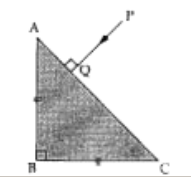Show with the help of a diagram how a total reflecting prism can be used to turn a ray of light through 90∘. Name one instrument in which such a prism is used.
To demonstrate how a total reflecting prism can turn a ray of light through 90 degrees, we can follow these steps:
1. Understanding the Prism: A total reflecting prism is typically a right-angled prism, often made of glass, with two of its angles being 45 degrees and one being 90 degrees.
2. Incident Ray: Consider a ray of light approaching the prism. Let's denote the prism as ABC, where angle A is the right angle (90 degrees), and angles B and C are both 45 degrees.
3. First Face (AB): The incident ray strikes the face AB of the prism normally (at a 90-degree angle). Since the ray is incident normally, it passes through without any deviation.
4. Second Face (AC): After passing through face AB, the ray reaches face AC. Here, it makes an angle of 45 degrees with the normal. Since the angle of incidence (45 degrees) is greater than the critical angle for glass, total internal reflection occurs. The ray reflects off face AC at an angle of 45 degrees.
5. Third Face (BC): The reflected ray then travels to face BC, where it strikes normally (at a 90-degree angle). Again, since it strikes normally, it passes through face BC without any deviation.
6. Resulting Path: As a result, the original ray of light has been turned through 90 degrees after passing through the prism.
7. Diagram: You can illustrate this with a diagram showing the ray entering the prism at face AB, reflecting off face AC, and then exiting through face BC.
8. Instrument: An example of an instrument that uses such a prism is a periscope, which allows observation from a concealed position by using total internal reflection.
Diagram:
C|/|/|/|∣A−−−−−B
- The ray enters at A, reflects at C, and exits at B.
C|/|/|/|∣A−−−−−B
- The ray enters at A, reflects at C, and exits at B.
Topper's Solved these Questions
- REFRACTION OF LIGHT AT PLANE SURFACESBOOK - ICSECHAPTER - REFRACTION OF LIGHT AT PLANE SURFACESEXERCISE - EXERCISE-4(D) MULTIPLE CHOICE TYPE
3 Videos
- REFRACTION OF LIGHT AT PLANE SURFACESBOOK - ICSECHAPTER - REFRACTION OF LIGHT AT PLANE SURFACESEXERCISE - EXERCISE-4(C) NUMERICALS
3 Videos
- REFRACTION OF LIGHTBOOK - ICSECHAPTER - REFRACTION OF LIGHTEXERCISE - DIAGRAM BASED MCQ:
5 Videos
- REFRACTION THROUGH A LENS BOOK - ICSECHAPTER - REFRACTION THROUGH A LENS EXERCISE - EXERCISE-5(D) (MULTIPLE CHOICE TYPE)
2 Videos
Similar Questions
What device other than a plane mirror can be used to turn a ray of light through 180∘ ? Draw a diagram in support of your answer. Name an instrument in which this device is used.
View SolutionShow with the aid of a ray diagram, how a right angled isosceles prism can be used to invert the rays. (a) How sould the rays fall on the prism ?
(b) Which phenomenon is responsible for this action of prism? (c) What is the nature of the image in relation to the object ?
View Solution
Knowledge Check
A total reflecting equilateral prism can be used to deviate a ray of light through :
A30∘B60∘C75∘D90∘A total reflecting right angled isosceles prism can be used to deviate a ray of light through :
A30∘B60∘C75∘D90∘
State one advantage of using a total reflecting prism as a reflector in place of a plane mirror.
View SolutionDraw a ray diagram to show a right angled isosceles prism may be used to ''bend the path of light rays by 90∘.
Write the necessary condition in terms of the refractive index of the material of this prism for the ray to bend to 90∘.
View SolutionA ray of light XY passes through a right angled isosceles prism as shown below.
Name the instrument where this action of prism is put into use.
View SolutionA ray of light XY passes through a right angled isosceles prism as shown alongside.
Name the instrument where this action of prism is put into use.

View SolutionA ray of light PQ is incident normally on the hypotenuse of a right angled prism ABC as shown in the diagram.

Name an instrument where this action of the prism is used.
View SolutionA ray of light PQ is incident normally on the hypotenuse of a right angled prism ABC as shown in the diagram given below:
Name an instrument where this action of the prism is used.
View Solution
